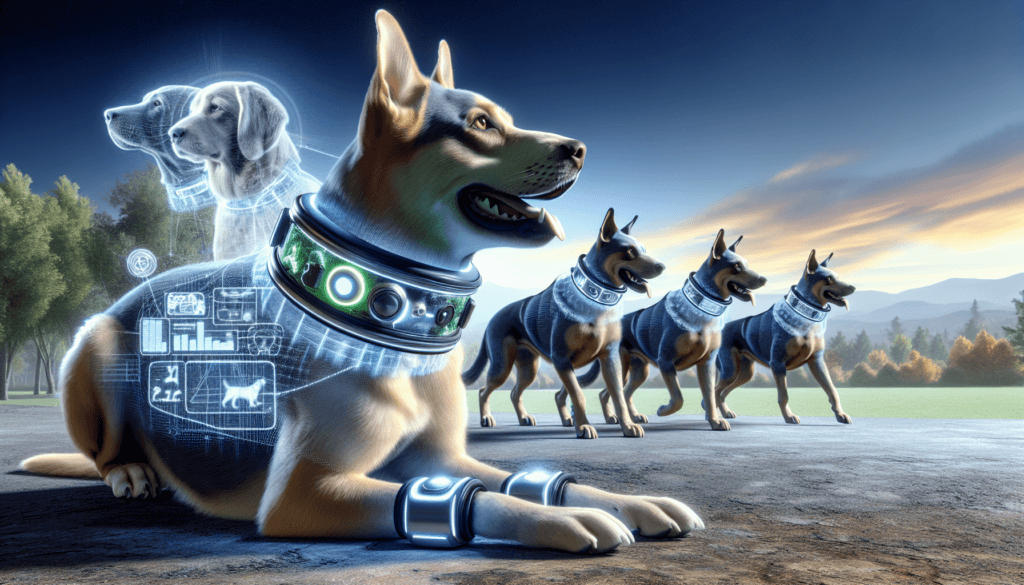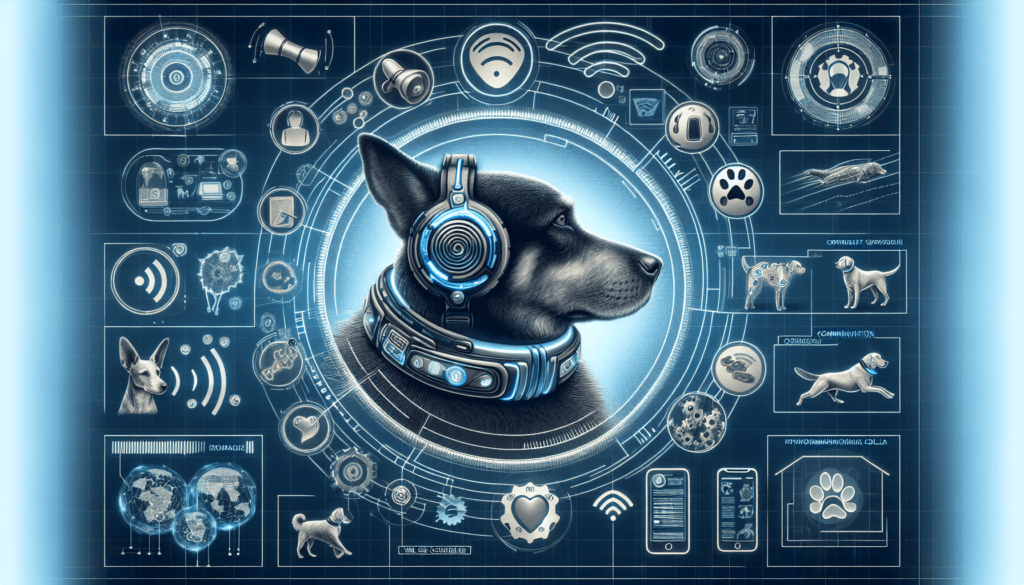Imagine a world where dogs are not just our best friends, but also expert communicators and coordinators within their own communities. With the advent of technology, this seemingly far-fetched idea may soon become a reality. In this article, we will explore the fascinating role that technology plays in enhancing dog communication and coordination within their communities. From wearable devices that enable dogs to communicate their needs to innovative apps that facilitate virtual playdates, join us as we uncover the exciting ways in which technology is revolutionizing the way dogs interact and collaborate with one another. Get ready to be amazed by the incredible ways technology is transforming the dog community!
Use of Social Media Platforms
Social media platforms have revolutionized the way dog owners and enthusiasts connect and communicate with each other. By creating online communities, individuals are able to share their love for dogs, exchange advice, and provide support in a virtual setting. These platforms allow users to create profiles for their dogs, share pictures and videos, and engage in discussions on various topics related to dogs. Whether it’s a Facebook group dedicated to a specific breed or a Twitter chat about dog training, social media platforms have fostered a sense of camaraderie among dog lovers worldwide.
Creating online communities
Social media platforms provide a space for dog owners and enthusiasts to come together and form online communities. These communities serve as a platform for like-minded individuals to share their experiences, seek advice, and discuss topics related to dogs. Whether it’s a Facebook group focused on dog health and wellness or a subreddit dedicated to dog training tips, these online communities provide a sense of belonging and support for dog owners.
Sharing information and resources
One of the key benefits of social media platforms in the dog community is the ability to easily share information and resources. From recommendations on dog products and services to training tips and techniques, social media allows dog owners to share their expertise and knowledge with others. This not only facilitates learning and growth within the community but also helps dog owners make informed decisions when it comes to the well-being of their furry friends.
Organizing events and meet-ups
Social media platforms have also made it easier for dog owners to organize and coordinate events and meet-ups. From dog walks and playdates to training workshops and agility competitions, social media platforms provide a convenient way for dog owners to connect and plan activities. By creating event pages, inviting other dog owners, and sharing updates, social media plays a significant role in bringing dog lovers together and fostering a sense of community and camaraderie.
GPS Tracking and Collar Technology
GPS tracking and collar technology have revolutionized the way dog owners keep track of their pets’ whereabouts and ensure their safety. These innovative devices provide real-time monitoring of a dog’s location, allowing owners to know exactly where their furry friends are at all times.
Real-time monitoring of dog’s location
GPS tracking devices and collars equipped with GPS technology provide real-time monitoring of a dog’s location. These devices use satellite signals to track the precise location of the dog, allowing owners to view their pet’s location on a smartphone or computer. This is especially useful for dog owners who have adventurous pets or live in areas with potential dangers, as it ensures that their dogs are always within a safe range.
Geo-fencing for safety
Many GPS tracking devices and collars also offer geo-fencing capabilities, allowing owners to set virtual boundaries for their dogs. If the dog crosses these pre-defined boundaries, the owner receives an alert on their phone, ensuring that the dog doesn’t wander off into unsafe areas or get lost. This feature is particularly beneficial for dog owners who live in urban areas or near busy roads, as it provides an extra layer of security to keep their pets safe.
Finding lost or missing dogs
Perhaps one of the most significant advantages of GPS tracking and collar technology is its ability to help locate lost or missing dogs. In the unfortunate event that a dog goes missing, GPS tracking devices can significantly increase the chances of a successful reunion. By tracking the dog’s location in real-time, owners and authorities can quickly identify the general area where the dog might be located and take appropriate action to reunite them with their loved ones.
Communication Devices for Dogs
Technology has advanced to the point where communication devices specifically designed for dogs are now available. These devices enable a whole new level of interaction between humans and their furry companions, enhancing the bond and understanding between the two.
Using wearable devices for communication
Wearable devices such as smart collars or harnesses equipped with communication technology allow dogs to communicate with their owners in a more meaningful way. These devices can be programmed to detect specific behaviors or actions from the dog, which can then be translated into signals or messages that humans can understand. For example, a dog’s wagging tail could be translated into a happy or excited message, enabling the owner to better understand and respond to their pet’s emotions.
Translation devices for human-dog interaction
Another fascinating development in communication devices for dogs is the emergence of translation devices that facilitate human-dog interaction. These devices use advanced algorithms and machine learning to analyze a dog’s vocalizations, body language, and facial expressions, and translate them into human language or visual signals. This breakthrough technology allows for a more natural and effective form of communication between humans and dogs, improving the overall understanding and connection between the two species.
Remote training and control devices
Technology has also brought about remote training and control devices that enable dog owners to train their pets from a distance or control their behavior remotely. These devices use various techniques such as vibration, sound, or mild electric stimulation to reinforce desired behaviors and discourage unwanted ones. With the help of these devices, owners can effectively communicate with their dogs, providing them with guidance and boundaries even when they are not physically present.
Online Training and Education
The advent of technology has greatly improved accessibility to dog training and education resources. Online training platforms and virtual classes have emerged as effective ways to receive professional guidance and learn essential skills to properly care for and train dogs.
Virtual training sessions and classes
Online training platforms offer virtual training sessions and classes that allow dog owners to learn from professional trainers and behaviorists from the comfort of their homes. These sessions provide step-by-step guidance on various aspects of dog training, from basic obedience commands to more advanced techniques. Virtual classes also provide an opportunity for dog owners to connect with other participants, ask questions, and engage in discussions, creating a supportive learning community.
Access to dog-related resources and information
The internet has become a vast repository of dog-related resources and information, ranging from articles and guides on dog health and nutrition to video tutorials on grooming and behavior management. Online platforms dedicated to dogs offer a plethora of information that dog owners can access at any time, allowing them to make informed decisions regarding the care and well-being of their pets. Having such easy access to valuable resources can empower dog owners to provide the best possible care for their furry friends.
Online certification and courses
For those seeking to deepen their knowledge and skills in the field of dog care and training, online certification programs and courses are now readily available. These programs offer comprehensive curriculum and assessments that cover a wide range of topics, including dog behavior, training techniques, and health management. By completing these online courses, individuals not only enhance their understanding and expertise but also gain recognized credentials that can boost career opportunities in the dog community.

Health Monitoring and Telemedicine
Technology has played a vital role in the monitoring and management of a dog’s health. With the help of innovative devices and telemedicine platforms, owners can now track their pets’ health data, consult with veterinarians remotely, and monitor medical conditions from the comfort of their homes.
Tracking and analyzing dog’s health data
Health monitoring devices designed for dogs enable owners to track and analyze various health parameters, providing valuable insights into the overall well-being of their pets. These devices can measure and record metrics such as heart rate, activity levels, sleep patterns, and even stress levels. By consistently monitoring these metrics over time, owners can detect any changes or abnormalities early on, allowing for prompt intervention if necessary.
Telemedicine consultations with veterinarians
In situations where a visit to the veterinarian may not be feasible or necessary, telemedicine platforms have emerged as a convenient alternative. These platforms connect dog owners with licensed veterinarians who can provide medical advice, diagnose certain conditions, and recommend appropriate treatment plans, all through virtual consultations. Telemedicine consultations not only save time and effort but also help reduce stress for both the dog and the owner, especially for routine check-ups or minor health concerns.
Remote monitoring of medical conditions
For dogs with chronic or ongoing medical conditions, technology offers remote monitoring capabilities that enable veterinarians to keep a close eye on their patients’ health. By using specialized devices and sensors, veterinarians can remotely monitor parameters such as blood glucose levels, heart rhythm, or medication adherence. This allows for timely adjustments to treatment plans and ensures that the dog’s condition is effectively managed, even from a distance.
Technology for Assisting Service Dogs
Service dogs play a crucial role in supporting individuals with disabilities, and technology has been instrumental in enhancing their training, communication, and overall assistance capabilities.
Training and communication devices for service dogs
Technology has greatly advanced the training methods for service dogs, allowing for more effective communication between the dog and its handler. From vibration collars that provide cues and direction to smart vests that enable touch-based communication, these devices help service dogs better understand and respond to their handler’s needs, helping them navigate daily life with increased independence and confidence.
Assistive technology for dogs with disabilities
In some cases, dogs themselves may have disabilities that require additional support. Technological advancements have led to the development of assistive devices such as prosthetics, orthotics, and wheelchairs specifically designed for dogs. These devices aim to enhance mobility, improve quality of life, and enable dogs with disabilities to perform tasks that would otherwise be challenging or impossible.
Smart homes and automation for accessibility
The integration of smart home technology and automation systems has significantly improved accessibility for service dogs and their handlers. From voice-activated commands to automated doors and lighting, these smart home features make it easier for service dogs to assist their handlers, perform tasks, and navigate their living environments. This level of automation not only enhances the efficiency of day-to-day activities but also promotes the overall well-being and comfort of both the dog and its handler.
Applications for Dog Adoption and Rescue
Technology has had a profound impact on the dog adoption and rescue process, making it easier for potential adopters to find their perfect furry companion and facilitating remote adoptions.
Matchmaking platforms for adopters and dogs
Matchmaking platforms specifically designed for dog adoption have emerged as a valuable resource for both potential adopters and rescue organizations. These platforms use advanced algorithms and detailed profiles to match adopters with dogs based on their lifestyle, preferences, and compatibility. By streamlining the adoption process and ensuring better matches, these platforms increase the likelihood of successful adoptions and reduce the chances of dogs being returned to shelters.
Virtual tours and information for shelters
Shelters and rescue organizations have leveraged technology to provide virtual tours and information about their facilities and available dogs. Through websites or mobile applications, potential adopters can explore shelters virtually, view pictures and videos of dogs available for adoption, and access detailed information about each animal. This virtual experience allows adopters to get a sense of the shelter environment, learn about the individual dogs’ personalities, and make educated decisions before visiting in person.
Facilitating remote adoptions
With the help of technology, remote adoptions have become a viable option for potential adopters. By utilizing video conferencing and online communication platforms, rescue organizations can conduct virtual meet-and-greets, interviews, and home checks to ensure a suitable match and environment for the dog. The ability to facilitate remote adoptions not only increases the reach and potential pool of adopters but also allows for faster adoptions, reducing the time dogs spend in shelters.
Monitoring and Managing Dog Behavior
Technology has opened up new possibilities for monitoring and managing dog behavior, providing owners with tools and systems that can detect potential issues and facilitate proactive intervention.
Smart cameras for behavior monitoring
Smart cameras equipped with artificial intelligence have become increasingly popular for monitoring and analyzing dog behavior. These cameras can detect and track specific behaviors, such as barking, chewing, or anxious pacing, and send alerts to the owner’s phone or computer. By providing real-time insights into their dog’s behavior, owners can better understand their pet’s needs and take appropriate action to address any behavioral issues promptly.
Apps for recording and analyzing dog behavior
There are now numerous applications available that allow owners to record and analyze their dog’s behavior over time. These apps typically offer features such as behavior tracking, mood monitoring, and activity analysis. By inputting information about their dog’s daily routines and behaviors, owners can identify patterns, track progress, and detect any changes that may require attention or intervention.
Alert systems for potential issues
Technology has also given rise to alert systems that can detect potential issues or emergencies related to a dog’s well-being. For example, wearable devices equipped with sensors can monitor vital signs, temperature, or even changes in environment for signs of distress or health concerns. When anomalies are detected, the owner is immediately notified, allowing for quick action and potentially preventing more severe outcomes.

Innovations in Dog Product Development
Advancements in technology have paved the way for innovative products designed to enhance the daily lives and well-being of dogs. From high-tech toys and entertainment devices to smart feeding and grooming solutions, dog product development has taken a leap forward.
High-tech toys and entertainment devices
Technology-driven toys and entertainment devices offer dogs mental stimulation, exercise, and engagement, even when their owners are not available. Interactive toys equipped with sensors, sound, and motion detection provide dogs with engaging play experiences. Some devices even have built-in treat dispensers or smartphone connectivity, allowing owners to interact with their pets remotely and monitor their activity levels.
Smart feeding and nutrition solutions
With the help of technology, feeding and nutrition have become more precise and tailored to individual dogs’ needs. Smart feeding devices can dispense precise portion sizes and schedules, ensuring dogs receive the right amount of food at the right time. Some devices can even connect to smartphones, allowing owners to monitor their pet’s feeding habits and adjust portions accordingly. Additionally, smart collars or wearable tags can track a dog’s activity and calorie expenditure, enabling owners to make informed decisions about their pet’s diet and overall nutrition.
Technological advancements in grooming
Grooming is an essential aspect of a dog’s overall well-being, and technology has introduced innovative solutions to enhance the grooming experience for both dogs and owners. High-tech grooming tools such as automated brushes or electric clippers offer efficient and comfortable grooming sessions. Moreover, apps or online platforms dedicated to grooming provide step-by-step instructions, video tutorials, and personalized recommendations, ensuring that owners can maintain their dogs’ hygiene and appearance with confidence.
The Future of Technology in Dog Community
As technology continues to evolve at a rapid pace, the future holds even more exciting advancements in the dog community. Here are some potential developments that we can anticipate:
Advancements in artificial intelligence and machine learning
Artificial intelligence (AI) and machine learning have the potential to revolutionize the way we interact with dogs. As these technologies develop further, we can expect more sophisticated devices that can understand and interpret dogs’ behavior, emotions, and needs with greater accuracy. This deeper understanding can help improve training methods, enhance communication, and lead to more personalized and tailored care for each dog.
Integration of technology with dog accessories and equipment
The integration of technology into dog accessories and equipment is likely to become more prevalent in the future. From smart collars and harnesses to GPS-enabled leashes and even wearable health monitoring devices, technology will be seamlessly incorporated into everyday dog items. These advancements will provide owners with greater convenience, safety, and peace of mind, as well as facilitate better communication and interaction with their furry companions.
Enhanced ways of understanding and communicating with dogs
The future holds endless possibilities for further enhancing our understanding and communication with dogs. Researchers are continuously exploring ways to develop devices that can interpret and translate a dog’s vocalizations, body language, and facial expressions into human language or visuals. This level of communication will bridge the gap between humans and dogs, allowing for even deeper connections and stronger bonds.
In conclusion, technology has played a crucial role in revolutionizing the dog community, enabling communication, coordination, and overall enhancement of the human-dog relationship. From social media platforms that create online communities to GPS tracking and collar technology that ensures the safety of our furry friends, technology has greatly enhanced our ability to connect, care for, and understand dogs. As technology continues to advance, the future holds even more exciting possibilities for the dog community, promising to further deepen our bond with our beloved canine companions.








